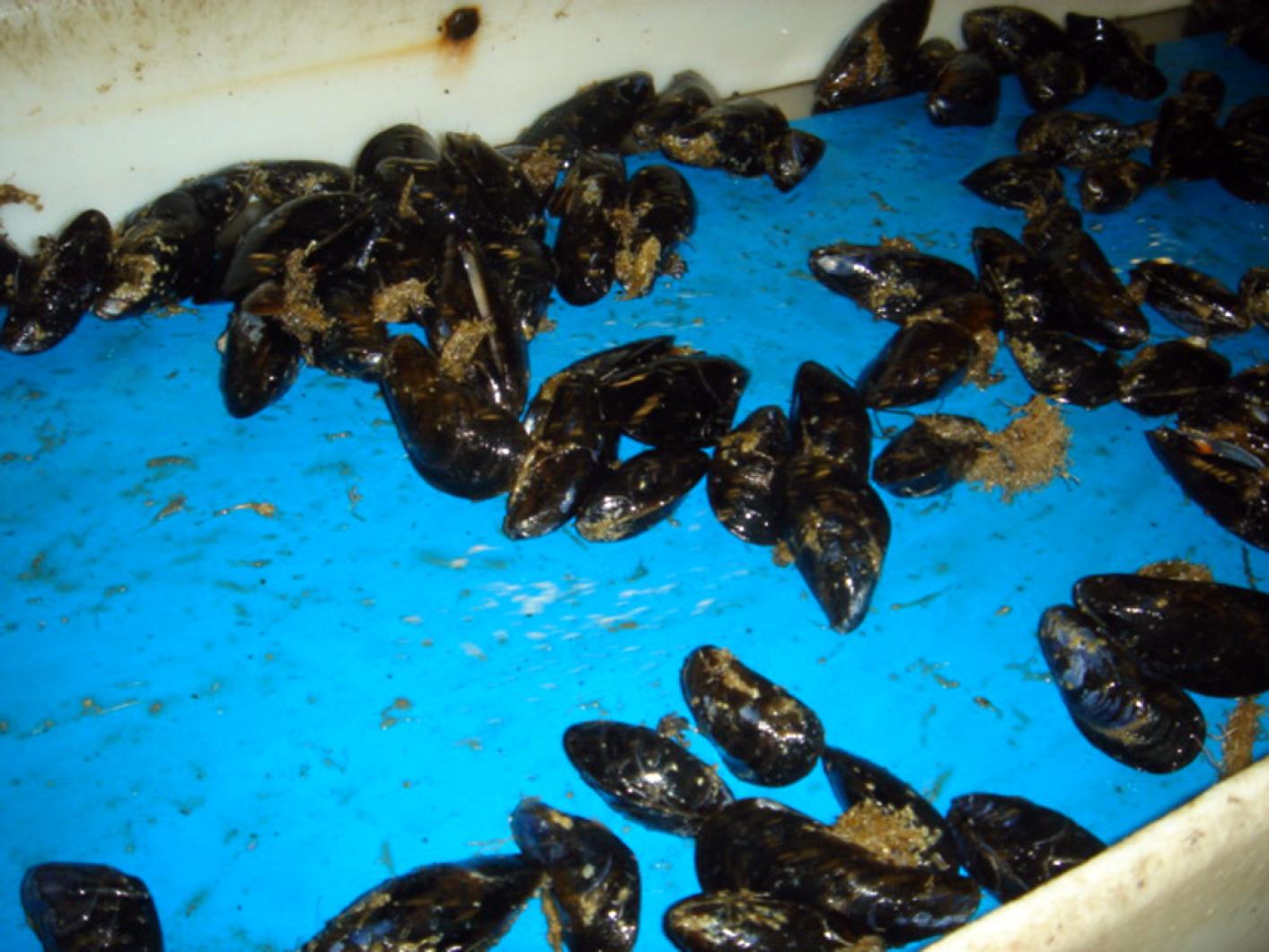The Vineyard’s first offshore farm-raised blue mussels will be distributed among Island fish markets and a few restaurants this weekend. The shellfish are being grown as part of a federally and locally-funded offshore aquaculture experiment to bring farm-raised blue mussels to market on the Island.
Alec Gale of West Tisbury was celebrating this week, despite the stormy, windy weather. Last Saturday before the storm arrived, he and his business partner, Tim Broderick, went out in Mr. Gale’s 55-foot offshore lobster boat Retriever to harvest 500 feet of line loaded with adult blue mussels. The experimental mussel farm is in Vineyard Sound, north of Chilmark. Mr. Gale estimated the weight of the product at the dock at around 2,000 pounds.
They left Menemsha at 5 a.m. and were unloading the blue mussels at a Woods Hole dock by 10 a.m. “It came up pretty easy,” Mr. Gale said.
The blue mussels were shipped from Woods Hole by truck to American Mussel Harvesters, Inc., based in North Kingston, R.I. At the plant, the shells were cleaned and the mussels made ready for market. About 800 pounds of mussels will be shipped back to the Vineyard for sale this weekend.
Mr. Gale said the blue mussels will be at the Home Port Restaurant in Menemsha, Offshore Ale in Oak Bluffs, and just about every fish market on the Vineyard, including Larsen’s Fish Market in Menemsha, Edgartown Seafood in Edgartown and the Net Result in Vineyard Haven. When it comes to retail sellers, Mr. Gale said: “We’ll deliver to whoever wants them.” Once the mussels are gone, they will be gone for awhile.
The project began in the autumn of 2006, when Richard Langan, an aquaculture specialist from the University of New Hampshire, came to the Vineyard to talk about the viability of raising blue mussels offshore on underwater lines. Offshore mussel farming had already proved successful at the Isle of Shoals in Maine. The talk at the Chilmark Library inspired a group of Island fishermen, many of whom have been struggling with hard times in the industry, to launch an experimental project.
Rick Karney, director of the Martha’s Vineyard Shellfish Group, and Scott Lindell of the Woods Hole Marine Biological Laboratory worked with others to get the project off the ground. A federal grant came through with the National Oceanic and Atmospheric Administration (NOAA) of $214,000 to underwrite the experiment in Rhode Island and Vineyard waters. Money also came from the Martha’s Vineyard Permanent Endowment Fund, which put $5,000 toward the project.
From 2006 to 2007, three buoys were set offshore with gear, just to see if the mussels would take hold and grow. Meanwhile, Mr. Karney and Mr. Lindell worked their way through a maze of federal and state bureaucratic red tape to get the project permitted. At one point, due to state objections, the experimental farm had to be reduced in scale just to get it started.
When all the paperwork was cleared, more than a year ago, the experimental farm was set up for operation by Mr. Gale and Mr. Broderick. The two men tended the underwater lines and monitored the project in challenging conditions that included high seas and strong currents. And last Saturday’s harvest was proof the project was worthwhile.
There is much excitement surrounding this limited one-time supply of farm-raised blue mussels. “Beaujolais nouveau!” exclaimed Mr. Karney, the longtime shellfish group director.
Mr. Gale said he is optimistic about the idea of mussel farming in Vineyard waters. But investors will be needed to help underwrite the real thing and the next step: a farm that can produce blue mussels year-round.
Bill Silkes, president of American Mussel Harvester Inc., said the harvesting of the first marketable mussels on the Vineyard is a big step not just for the Island but for the region. “This is huge. There is a tremendous market in the United States for mussels that grow faster and are closer to the market,” he said. Mussels coming from Maine and Canada are slower growing. In most cases, blue mussels take 18 months to reach marketable size. In Vineyard waters, based on the group’s research, it only takes one year.
Most of the mussels consumed in the United States comes from Canada and New Zealand. Canada ships 30 million pounds a year to the United States, Mr. Silkes said.
“There is an opportunity for a whole industry to develop,” he said, noting that local fishermen already have the boating experience and already have their own boats. A mussel farm fishery could augment what the small commercial fishermen are already doing, he said.
Mr. Silkes said he gets his blue mussels from Maine and from Rhode Island fishermen. The Vineyard would be a neighbor.
Mr. Gale said he welcomes interest from anyone interested in investing in a Vineyard offshore mussel farm of the future. He can be reached at 508-693-3279.







Comments
Comment policy »